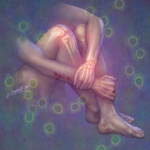
Dr. Rogers
Adopting the type 1 and type 2 model revolutionized how Jennifer Rogers, MD, and her colleagues at the Duke Lupus Clinic deliver care. “Patients attribute symptoms of fatigue and widespread pain to lupus, because many of these symptoms developed at the onset of their disease, are often the most bothersome symptoms and can result in poor health-related quality of life,” says Dr. Rogers, director of the clinic and an assistant professor of medicine, Division of Rheumatology and Immunology, at Duke.
“By incorporating these symptoms into the nomenclature of SLE, the provider is encouraged to recognize, discuss and manage these symptoms,” explains Dr. Rogers in an email. “Instead of spending time disagreeing or explaining why fatigue is not due to lupus, we spend time empathizing with the patient, explaining why escalating immunosuppression is not needed for type 2 SLE, and working with the patient to find ways to improve their type 2 symptoms.
“Using our model could, therefore, improve communication and trust between patients and physician, which could then improve patient understanding and buy-in for non-immunosuppressive treatment modalities (e.g., exercise, sleep hygiene, treating depression, weaning steroids).”
Another advantage to this categorization is that it can lead to more appropriate drug therapy, says Dr. Pisetsky, noting that some lupus patients receive immunosuppressive agents to treat inflammation when that is not the problem. Type 2 lupus symptoms may require different medications and approaches to therapy.
Research Benefits
Lupus researchers at Duke plan new studies to explore categorization of lupus systems under the model with the aim of developing new approaches for diagnosis and treatment. One day, this model may also be useful in studying other rheumatic diseases, says Dr. Pisetsky.
“We always need to put the patient first,” says Dr. Pisetsky. “I think it’s important to have new ways to hear what their symptoms are and then respond appropriately.
Catherine Kolonko is a medical writer based in Oregon.
Reference
- Pisetsky DS, Clowse MEB, Criscione‐Schreiber LG, Roger JL. A novel system to categorize the symptoms of systemic lupus erythematosus. Arthritis Care Res. 2019 Jun;71(6):735–741.

